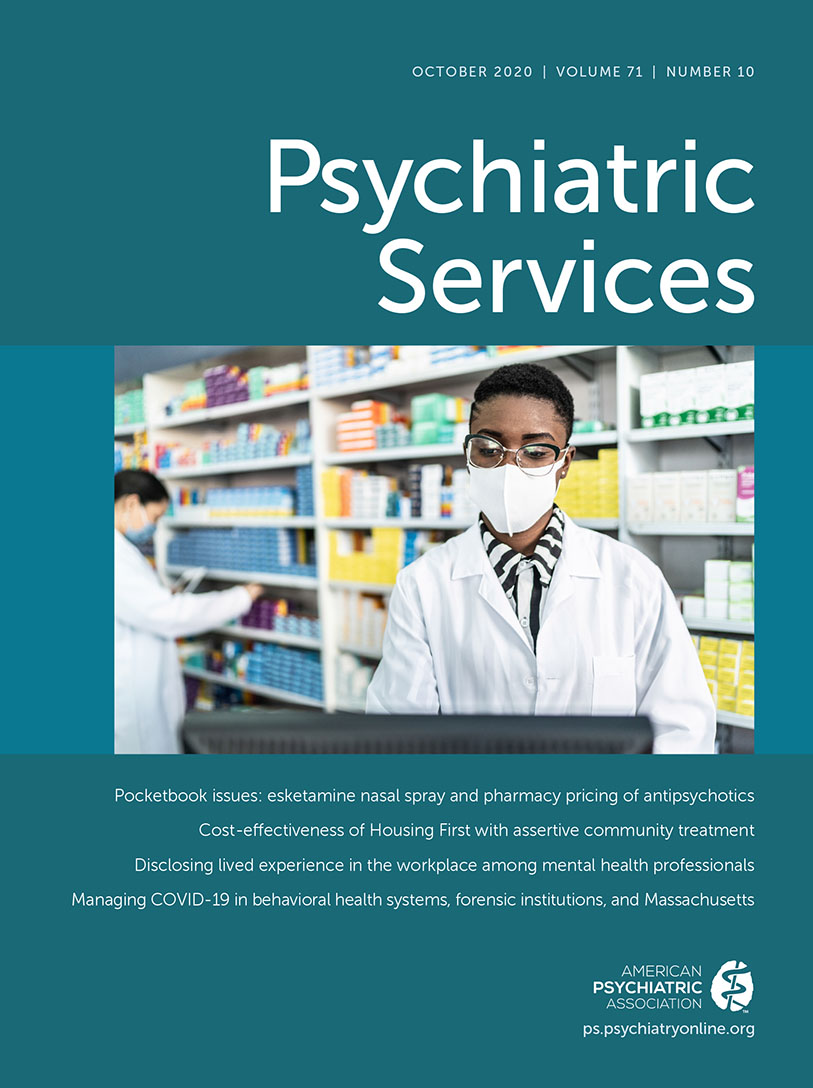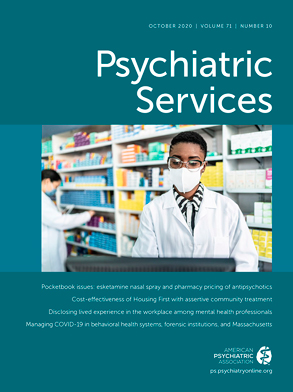In 2020, the world became familiar with COVID-19, an illness caused by a novel coronavirus and characterized by fever and respiratory symptoms that can progress to death (
1–
3). The Centers for Disease Control and Prevention published recommendations for minimizing the spread of COVID-19 in various health care settings (
4), and several leading mental health organizations compiled resources to help guide psychiatric treatment during the pandemic (
5–
7). Li (
8) recently provided specific guidance on the prevention and management of COVID-19 in inpatient psychiatric units, and the American Correctional Association (
9) disseminated information about correctional settings. However, guidance about the challenges posed by COVID-19 in forensic psychiatric institutions is lacking.
Guidance specific to forensic psychiatric institutions is necessary because these settings differ significantly from both acute-care psychiatric hospitals and correctional institutions. In acute-care psychiatric hospitals, length of stay is measured in days, and discharge readiness is primarily based on clinical stability. In contrast, length of stay in forensic hospitals often is measured in months or years, and admissions and discharges are coordinated with, and frequently dependent on, outside agencies, including courts, prisons, jails, and quasi-judicial administrative bodies. Most patients in forensic hospitals have histories of serious violence as well as ongoing criminal justice involvement that complicates their care. All of these factors present challenges that must be addressed when designing protocols for managing COVID-19 and similar future epidemics of communicable diseases. This column outlines these challenges and strategies to address them.
Institutional Adaptations to COVID-19
Like other hospitals, forensic institutions must develop specific policies related to utilization of personal protective equipment (PPE), testing of patients and staff, and management of suspected and confirmed COVID-19 cases. Implementing such policies is particularly challenging when working with patients who are psychiatrically impaired and may be unwilling or unable to comply with recommendations to wear face masks or to remain in designated isolation areas. Identifying a pathway to implement such interventions with forensic patients, who may be at heightened risk for aggression or violence, becomes even more complex. Typical measures to manage violence, including restraint, seclusion, and/or involuntary medications, do not allow for any measure of social distancing. As such, staff must have ready access to necessary PPE to keep themselves as medically safe as possible while physically intervening to keep patients and staff safe from aggression. The use of psychotropic medications to manage aggression also must be balanced with ensuring patients’ medical stability, particularly with respect to respiratory status.
In forensic settings, it is important to clearly distinguish between infection prevention recommendations and requirements for both staff and patients. Communicating this clear distinction to both parties may help to avoid unnecessary power struggles and conflict over issues that are merely recommendations, such as expectations regarding patient mask use. In addition, patients may be able to accept change more readily when the rationale and plans are explained over time and in terms of their own health and safety.
In addition to implementing restrictions on visits by family and friends, forensic hospitals must decide how to handle professional visitors such as attorneys, conservators, and disability rights advocates, whose access to patients ordinarily has few restrictions. One mechanism for addressing these concerns is the use of video communication. For example, in our institution, HIPAA-compliant videoconferencing software was installed for professional visits, and smartphones were purchased for remote communication between patients and family or friends (smartphones could not be used for professional visits because they were not HIPAA compliant). Although such technologies may pose a challenge with patients who have histories of sexually problematic behavior or who may attempt to contact victims of prior offenses, these risks must be balanced against the threat to patients’ rights that comes from limiting access to legal advocates and contact with family members. In most cases, safeguards such as supervision by staff and protective coverings for the video equipment can sufficiently mitigate potential risks.
Staff in forensic institutions are often designated as “hazardous duty” employees who receive extra pay and benefits for working under conditions of hardship. This designation may limit the hospital’s ability to allow teleworking, a commonly employed strategy to manage workforce issues in psychiatric hospitals during the pandemic, because state governments may deem that employees should not receive the financial benefits of working in a “hazardous” environment when working from home. One alternative strategy to address this challenge is to utilize satellite work locations on the hospital’s campus, if available, on a rotating basis. Satellite work sites allow employees to continue to report to work without exposing themselves to confined inpatient units, where the risk of viral exposure may be heightened. This approach also preserves a backup workforce off site, should COVID-19 infections require self-quarantine by the onsite employees.
Collaborating with Legal and Criminal Justice Systems
Forensic mental health services require collaboration with several partners in the legal system, including departments of correction (DOCs) and criminal and probate courts. Communication with partner agencies is important during routine operations but is even more critical during a pandemic. These agencies share several important goals with forensic hospitals, including infection prevention, provision of adequate mental health care, and expeditious resolution of legal matters.
Liaison with corrections.
Both mental health agencies and DOCs share the goal of minimizing COVID-19 exposure and spread in their populations. Solely from an infection prevention perspective, the ideal scenario would be to stop all movement between institutions. However, other important goals, such as providing treatment to incompetent defendants sent by the courts and returning competent defendants to court to face their charges, must be considered as well. In our institution, movement between the hospital, DOC facilities, and the courts came to a standstill in the early stage of the pandemic. As the situation persisted for weeks, it became clear that systems had to slowly return to normal operations. To this end, communication with correctional systems allowed for the development of shared expectations, such as offering COVID-19 tests to individuals who were anticipated to move between institutions. This cooperation required planning and coordination because the different systems had variable access to testing and the time for test results to return varied. Each agency also developed protocols for how to manage infection risk for patients who refuse testing prior to transfer but who must be accepted by the institution because of a court order, typically leading to the medical isolation of the individual in his or her new setting for up to 14 days.
Liaison with criminal and probate courts.
During a pandemic, criminal courts severely limit their operations, with most courts handling only arraignments and “high-priority” matters. From the forensic hospital’s perspective, all competency restoration cases should be considered high priority for the court because making a final determination about competency allows the hospital to discharge patients and reduce the institutional population among which infection can spread. However, courts may not share this view. Finding allies within the court system, such as a chief administrative judge, clerk, or case flow coordinator, is essential. In addition, it is useful to have a point person at the hospital to coordinate videoconference hearings, troubleshoot with IT professionals, and interface with judges and other court personnel to ensure a smooth process. During a pandemic, there must also be mechanisms for continued work with probate courts around matters such as civil commitment, conservatorship, and involuntary medication, and the well-being of additional stakeholders, including conservators, family members, and court-appointed attorneys and physician evaluators, must be considered. Investing in videoconferencing equipment that allows for remote criminal and probate court hearings is money well spent because it ultimately may decrease length of stay, census, and accordingly, the hospital’s risk of spreading the infection.
Even when courts are willing to work with the hospital to resolve patients’ criminal matters, challenges may still arise. For example, the logistics of conducting hearings via videoconference can be complex, particularly in contentious cases, cases where repeated communication between the patient/defendant and the attorney is necessary, and cases where multiple exhibits and physical evidence must be presented. Institutions must identify a mechanism to permit attorney-client contact during or after proceedings to allow attorney-client communication. For instance, suspending the hearing, excusing everyone except the patient/defendant and an agency police officer from the room, and permitting communication via telephone, although not foolproof, can help to ensure that the patient/defendant’s rights are respected.
Liaison with judicial bodies overseeing insanity acquittees.
Forensic hospitals must collaborate with criminal courts or quasi-judicial administrative bodies that oversee the treatment and/or release of insanity acquittees. Often, these judicial bodies require the hospital to obtain permission before deviating from a court-ordered treatment plan. In a pandemic, such procedures may be impractical, given the large number of patients who would need modifications to their treatment plans. For example, prescribed group therapies may no longer be occurring in an effort to prevent infection spread, and other treatment and monitoring activities may be curtailed because of staffing shortages or social-distancing guidelines. In such instances, maintaining close collaboration with the entity overseeing the management of insanity acquittees is crucial. Assigning a hospital staff member to keep track of deviations from patients’ treatment plans and to inform the oversight body of such deviations is key.
In the early stages of a pandemic, one of the chief questions facing a forensic hospital is how to handle the care of patients who have been living in the community part-time as a gradual transition out of the hospital. Returning patients from the community to the hospital should ideally be avoided to prevent the spread of infection. Hospitals must decide whether to keep these patients entirely in the community or the hospital. These determinations are best made after considering factors such as the patient’s risk of clinical decompensation, the ability to maintain adequate monitoring in the community, available community treatment resources, and the patient’s preferences.
Discharge Challenges
During a pandemic, forensic hospitals face tremendous pressures to discharge patients. Doing so mitigates risk both to the individual, as institutions often become “hot spots” of infection, and to the institution, as a lower patient census allows greater opportunity for social distancing and flexibility in individualized treatment planning. Disability rights advocates also may apply external pressure to discharge patients rapidly through lawsuits or media campaigns. These forces can be powerful, but institutions must be cautious that they do not result in careless discharge planning.
Under normal circumstances, coordinating discharge arrangements for forensic patients under time-limited court orders, such as for competency restoration, is challenging. With frequent homelessness, limited bed availability, and a release date that may be dependent on the courts, aligning the necessary components for a comprehensive discharge plan can be difficult. During the pandemic, additional challenges arise, including communicating with mental health professionals who are teleworking or on altered schedules, overcoming the reluctance of community agencies to accept new admissions, and testing patients for COVID-19 to meet community facilities’ admission requirements. Furthermore, given the shift to telehealth, forensic hospitals may be hesitant to release individuals to a setting where their face-to-face contact with outpatient providers is limited, because intensive treatment and monitoring are often vital components of community success. Frequent and reciprocal communication among the hospital, community providers, and the courts as well as ongoing education for patients about the public health risks and recommended mitigation strategies are key components to working through these challenges.
Conclusions
The COVID-19 pandemic has created new challenges and barriers to care. Some of these challenges are particular to forensic psychiatric hospitals, which sit at the intersection of two public systems with sometimes differing goals: mental health and criminal justice. Regional variations make it difficult to provide overarching guidance to hospitals in all jurisdictions. However, a renewed focus on communication, collaboration, and flexibility between both systems can allow all parties to maintain safety and achieve the best possible outcomes for patients.

